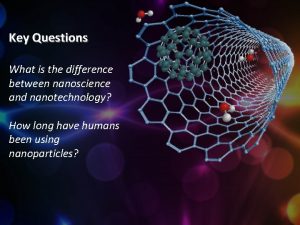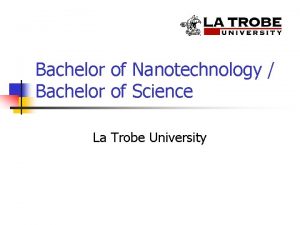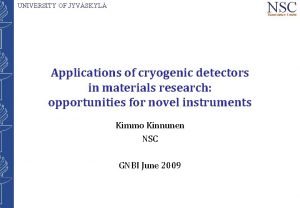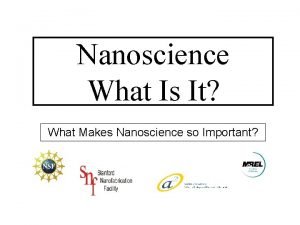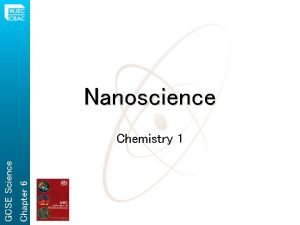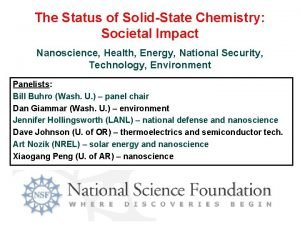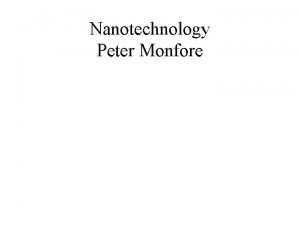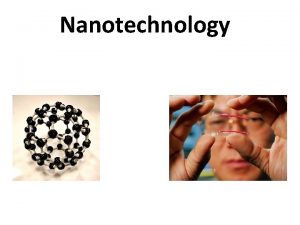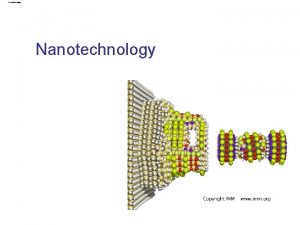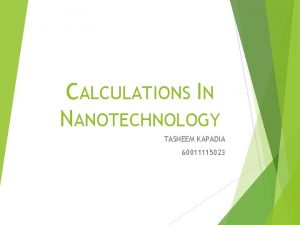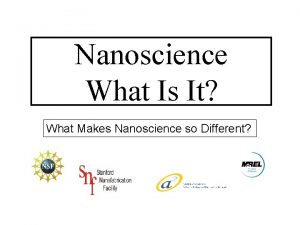Nanoscience and Nanotechnology The Wisconsin Institutes for Discovery









- Slides: 9

Nanoscience and Nanotechnology The Wisconsin Institutes for Discovery (Nano + Bio + Info)

1027 How small is a Nanometer ? Universe (largest length) Taking a human as reference, the Sun is a billion times larger, 10– 3 mm 10– 6 m 10– 9 nm 10– 35 a nanometer a billion times smaller. Planck Length (smallest length)

How small is a Nanometer ? Each panel 10 x smaller Each time something different 125 nm Hewlett-Packard molecular memory Two more steps to reach one nanometer

Fundamental Length Scales Consider devices operating at room temperature. Their energy levels have to be separated by more than thermal energy k. BT = 25 me. V. Convert this energy scale to a length scale by fundamental constants. Quantum Well: Quantum Well Laser Electric Capacitor: Single Electron Transistor Magnetic Particle: Data Storage Media E 1 E 0 l d Energy Levels Charging Energy 3 h 2/8 m l 2 2 e 2/ d l < 7 nm d < 9 nm a = V 1/3 Spin Flip Barrier ½ M 2 a 3 a > 3 nm

Quantum Length Scale: The Quantum Well Laser 6 nm optimum thickness, comparable to the electron wavelength

Confinement in Nanocrystals Quantum confinement : Crystal size determines the color (blue-shifted when smaller)

When Does Silicon Cease to be Silicon? The band gap of silicon nanoclusters Ga. As Bulk Silicon 3 nm : Gap begins to change

Electric Length Scale: Single Electron Transistor e- edot Cg To add one extra electron to the dot requires the voltage Vg e/Cg (Cg= Qg/Vg = gate/dot capacitance). This costs the charging energy UC = e Vg = e 2/Cg. Vg The smaller the dot, the smaller the capacitance, the larger the charging energy per electron. Vg e/Cg N-½ N+½ N N-1 Electrons on the dot This effect can be observed when the charging energy becomes larger than thermal energy: UC > k BT For room temperature operation (k. BT = 25 me. V) this happens when the dot is smaller than 10 nm.

Magnetic Length Scale: Superparamagnetic Size Limit Energy Barrier E When ferromagnetic particles become smaller than about 10 nm , they lose their magnetism over time (a few years at room temperature). The thermal energy can flip all the spins in a particle (see Lect. 24, Slide 10). If one measures magnetic hysteresis loops (Lect. 23, Slide 4) at various temperatures, they switch rather suddenly from ferromagnetic loops to paramagnetic lines at a temperature called the blocking temperature. This looks like the magnetic phase transition at the Curie temperature, but it depends on how fast the measurement is performed.

